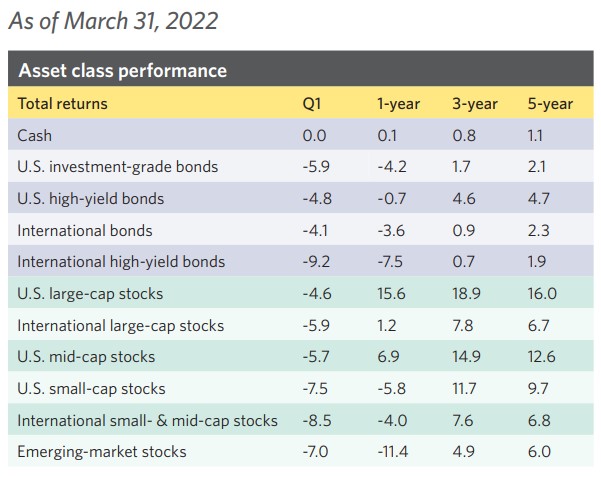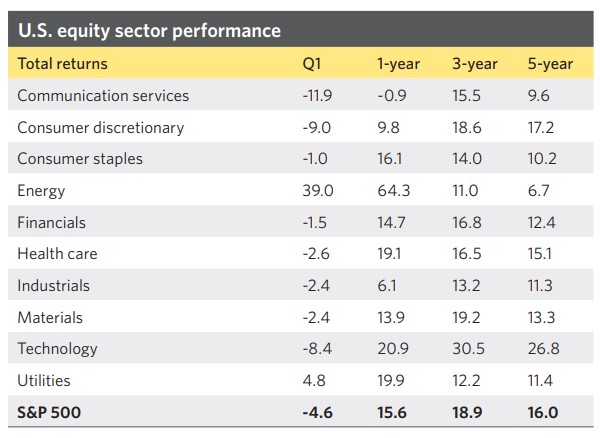Market Facts
Not in Rubles – Russia has until Wednesday, May 4th, to pay $2.2 billion of foreign debt that was originally due to be paid to an American bank on April 4, 2022. If Russia is unable to repay the debt in US dollars as it is required to do, the default on foreign debt would be Russia’s first since 1917 during the Russian revolution (source: AP).
Open Arms – As of Thursday 4/14/2022, 57% of the 4.7 million Ukrainians (2.7 million people) that have fled their country since 2/24/2022 have escaped to Poland, a nation of 38 million people (source: United Nations).
High, Low – For the 9 years from 1973-1981, inflation (using the “Consumer Price Index”) averaged +9.2% per year. For the 9 years from 2012 to 2020, inflation averaged +1.6% per year (source: Bureau of Labor Statistics). Again using CPI, inflation was up +8.5% for the 1-year ending 3/31/2022. That’s more inflation than the United States experienced over the 4 years of 2017-2020 when the CPI advanced +7.9% over the entire 4 years (source: Department of Labor).
Disappearing Act – 60% of American workers born in 1943 were employed by companies that provided a defined benefit pension plan. Just 6% of American workers born in 1964 were employed by companies that provided a defined benefit pension plan (source: Center for Retirement Research).
Housing Shortage – The United States is an estimated 3.8 million homes short of the demand that exists in the country for single-family homes (source: Freddie Mac).
Market Indices



Quarterly Recap
Economy – The U.S. economy decelerated but continued to expand. Inflation persisted, with the Consumer Price Index (CPI) hitting a 40-yearhigh as the demand-driven, supply chain-constrained environment continued. Together with tightening labor conditions, the Fed launched its rate hike campaign. Consumer spending remained steady, although inflation, stock price volatility, and ebbing consumer confidence posed threats. Internationally, optimism about above-trend economic and earnings growth was tarnished somewhat by tightening monetary policies and uncertainty regarding the ultimate impact on Europe after Russia’s invasion of Ukraine. China’s stagnant growth continued, and the U.S. dollar remained firm, applying pressure on global growth, while the persistent surge in commodity prices, notably crude oil, grains, and metals aided resource-reliant economies.
Equities – Global equity markets witnessed heightened downside volatility as global monetary policies began to tighten. The virus continued to disrupt activity, supply chain challenges persisted, and inflation sizzled. The Russian invasion into Ukraine exacerbated the backdrop as markets grappled with the global implications of a war. Surging inflation, tightening financial conditions, and festering pandemic disruptions were chief among the drains on conviction, partially offset by continued above-trend economic growth. Weak currencies also held back many emerging markets. Chinese stocks struggled as weaker economic growth weighed on consumer discretionary stocks, and technology fell in the wake of a government clampdown on some high-profile companies.
Income – The Fed has embarked on its rate hike campaign, which is expected to deliver multiple rate rises in 2022 and 2023. The March Federal Open Market Committee (FOMC) statement cited strength in economic activity but “highly uncertain” economic implications of the war in Eastern Europe. With high inflation and tightening monetary policies, in addition to the uncertainty regarding the impact on economic growth, Treasury yields have seen a wild ride that led to higher rates.
Commodities – The advance in commodity prices was resuscitated by the crisis in Europe, which saw energy, grain, natural gas, and metals prices surge, defying ongoing weakness in Chinese growth, and strength in the U.S. dollar. The S&P GSCI rose during Q1 but relinquished some of the gains with volatility toward the end of the quarter. While demand for oil continues to recover, supply has been curtailed by OPEC and a slow return of U.S. production capacity—although the market is becoming more balanced with the U.S. rig count rising and inventories stabilizing. The Energy Information Agency (EIA) forecasts global supply and demand to converge in 2022. Gold regained its inflation “go-to” status and has threatened the record highs reached a year ago.
